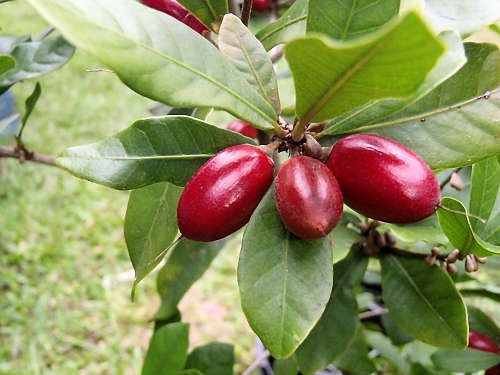Growing Miracle Fruit:
Synsepalum dulcificum
Back to Fruit, Berries and Nuts
Botanical Overview
A member of the Chicle family (Sapotaceae), which includes Mamey Sapote and Sapodilla, Miracle Fruit is the best known of 29 species in the Synsepalum genus.
Description
Form:
A shrub or, in its native environment, a small tree.
Lifespan:
At least 25 years.
Leaf retention:
Evergreen.
Growth rate:
Slow in the first year, then between slow and moderate, depending on conditions.
Mature Size:
Normally no more than 6' (1.8m) high, but up to 15' (4.5m) in a favorable climate.
Flowers:
Five white petals wrapped in a tubular shape, opening fully once pollinated.
The flowers appear in small clusters.
Bloom:
Several times a year in frost-free regions.
Self-fruitful:
Yes, when hand pollinated with a tiny artist brush or a toothpick. A second plant nearby
may improve pollination rates.
Years before fruiting:
The plant starts to flower when about 1-1.5' (30-46cm) tall, in 2-4 years, depending on
growing conditions.
The flowers will set fruit when the plant is about 2' (60cm) tall.
Fruit:
Oval with a small point or nipple, about 1" (2.5cm) long, thin skin changing from green
to strong red when ripe, pink translucent flesh, with a single seed.
The raw fruit causes one's mouth to taste sour foods as sweet.
Months for fruit to ripen:
2.
Storage after harvest:
This fruit can be eaten raw or frozen immediately. It spoils quickly and cannot be cooked
without losing its flavor-changing properties.
Leaves:
Green, elongated, smooth margins. New leaves are red and turn green over time.
Stems:
No thorns.
Roots:
Fibrous, not invasive.
Wildlife:
The flowers do not noticeably attract insects; a native pollinator has not been identified.
The fruit attracts birds.
Toxic / Danger:
No.
Origin:
Central West Africa.
Cultivation and Uses
USDA hardiness zones:
10b-11. Young plants are killed at 32°F (0°C). Older plants will survive 32°F
(0°C) for short periods.
This tropical plant may experience leaf loss below 40°F (4.4°C).
Chill hours:
None.
Heat tolerant:
No.
Drought tolerant:
No.
Sun:
Outdoors, in temperatures over 85°F (29.4°C), all day open shade with no direct sun.
All day part shade in lower temperatures. Indoors, by a south-facing bright glass window kept
closed.
Planting:
This plant is best grown indoors, next to a south-facing window, in a well-draining container.
The container must contain extremely acidic soil. The plant should be repotted,
every 1-2 years, in a pot one size larger, with more extremely acidic soil, otherwise growth
will stall.
Located outdoors, it needs all day open shade when temperatures exceed 85°F (29.4°C). It should be brought inside when temperatures are expected to go below 40°F (4.4°C).
Located outdoors, it needs all day open shade when temperatures exceed 85°F (29.4°C). It should be brought inside when temperatures are expected to go below 40°F (4.4°C).
Soil:
50% peat moss and 50% perlite, moist, well draining, pH 4.0-5.0 (extremely acidic). The mix
must provide both airflow and moisture, which can be adjusted with more peat moss to stay
moist longer, or more perlite to dry faster. The plant will tolerate pH 5.1-5.5
(strongly acidic) soil but will not grow as fast or be as healthy.
Fertilize:
Apply plant micronutrients to irrigation water, at a rate of 1/4 tsp (1.25 ml) in one gallon
(4 liters) of previously acidified water, every time the plant is watered.
Apply a small amount of organic fertilizer every 3 months to the top of the soil.
Adding a small amount of iron sulphate to the fertilizer will also improve growth.
Water after becoming established:
The soil must always be moist, never too wet and never too dry, when the plant is young, when
temperatures go over 85°F (29.4°C), and in low humidity.
Adjust the soil mix so that it needs water every 5-7 days, using water supplemented with
citric acid and vinegar to lower the pH between 4.0-5.0.
Use litmus paper strips (pH test strips) or a reliable pH meter to measure soil and water
acidity.
Mulch:
When the plant is grown outdoors, organic mulch spread over the root area can reduce soil
evaporation loss. Mulch should not be used indoors.
Prune:
There is usually no need to prune this plant. It blooms on one year old wood.
Propagation:
Use fresh seed, which will take 4-10 weeks to sprout. Sprouting in pH 4.0 soil will cause
quicker germination. Seed become non-viable within 1-2 days after exposure to air and do not
survive being dried or frozen. Cuttings take a long time to root and must have low pH soil.
Uses:
The fruit, when eaten so that tongue and teeth remove all flesh from the seed, change the
flavor of sour foods to sweet. Two to three fruit are needed for the full effect, which lasts
one-half to one hour.
Comments
Another name for this fruit is Miracle Berry.
This plant does not need high humidity when it has continuously moist, extremely
acidic soil. Most plants cannot handle soil so acidic.
Do you have additional information or a different experience for these plants that you would like to share? Email info@GardenOracle.com. All contributions are welcome and appreciated.
Do you have additional information or a different experience for these plants that you would like to share? Email info@GardenOracle.com. All contributions are welcome and appreciated.


Latest update: January, 2024
© 2008-2025 by GardenOracle.com

